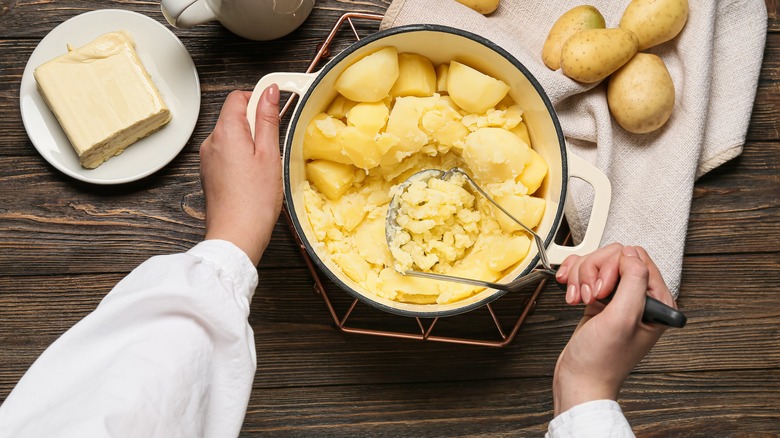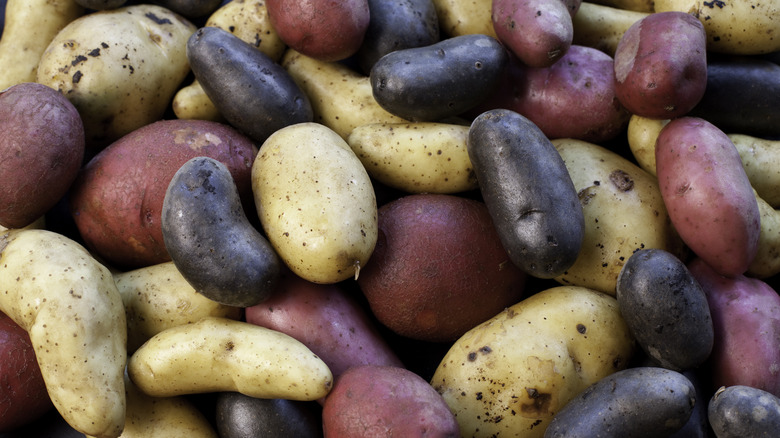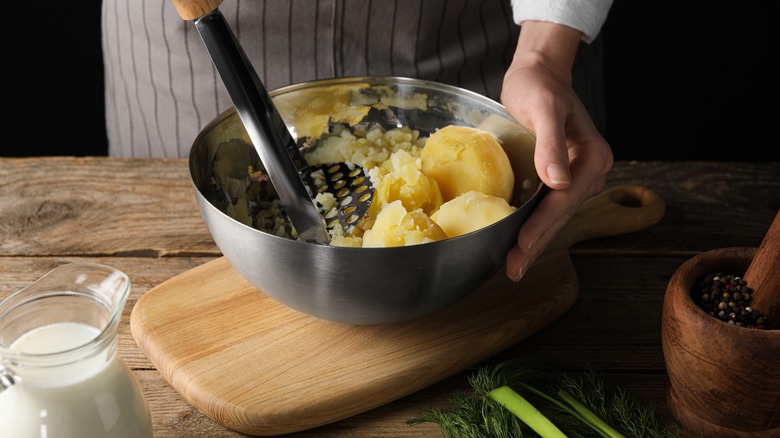For Mashed Potatoes With Some Texture, Simply Smash Them By Hand
Whether you use them to fashion the top crust of a shepherd's pie or plate them alongside a slow cooker pot roast, mashed potatoes are one of the greatest side dishes of them all. Satiating, creamy, and downright luxurious, there's nothing negative to say about mashed potatoes.
Thanks to modern kitchen tools, mashing potatoes is an easy process. Whether it's a food processor, blender, or stand mixer, there are plenty of ways to make mashing potatoes quick and painless. But a perfectly smooth batch of mashed potatoes can become monotonous, and if you're craving mashed potatoes with a bit of hearty texture, ditch the high-tech tools and smash them by hand instead.
Because it can release excessive starches, overmixing potatoes with an electric mixer leads to a gummy potato texture — a culinary faux pas. Although it takes a little extra time and elbow grease, mashing potatoes by hand allows for more control over the final texture as you can adjust the pressure and duration of mashing. The result? A batch of lush mashed potatoes freckled with delicious pieces of whole potato. The change in texture and mouthfeel will definitely defy a monotonous potato routine.
Which potatoes work best
Now that we've established that hand-mashing potatoes results in a batch of spuds with more texture, it's important to consider the different variations of potatoes so that you can get the most enjoyment out of them. And as it turns out, the potato cultivar you select can make or break your mashed potatoes. The most important detail to remember when picking out your potatoes is to select low-moisture, high-starch varieties for achieving a light and fluffy texture.
One tried and true variety for hand-mashing potatoes is a classic Russet potato whose cell structure breaks down easily when cooked, lending to a hand-mashing experience that requires minimal effort. Another great high-starch option for hand-mashing spuds is Yukon golds. Not only do they encourage a mellow mashing process, but they also have a rich and buttery flavor that makes for a luxurious spread of textured mashed potatoes.
Avoid hand smashing with high-moisture content varieties like red potatoes, fingerlings, and baby potatoes as they can take on a pasty and dense quality and often require more mashing effort. Save those for boiling and adding to soups instead.
Tips for hand-mashed potatoes
Mashing potatoes is a relatively easy process that doesn't require Michelin-star skills. However, hand mashing is a more labor-intensive process than those that rely on electric mixers (but the clean-up is quicker!). But with a few tips in mind, you'll have a heaping pot of rustic, well-textured mashed potatoes in no time.
Instead of pre-boiling the water to cook the potatoes, submerge them in cold water and slowly bring them to a boil to promote even cooking. Cook the potatoes until they're super tender to minimize effort and maximize ease of smashing. To tell if they're ready to be smashed to (almost) oblivion, puncture them with a fork. If there's resistance, keep cooking until the fork smoothly slides into the potato.
Cutting the potatoes into smaller pieces before or after they cook can reduce the amount of force needed to mash them. Using a large fork or hand-held potato masher is your best bet for easy mashing. Always add your warm cream and melted butter during the mashing, as they'll make the job easier and they're ingredients that can boost the texture of mashed potatoes too. You should be able to tell just by looking at the potatoes how smooth or textured they are, and once they've reached your desired consistency, get to eating. Next time you're craving a heartier batch of mashed potatoes, hand-mash them. The work is worth it!


